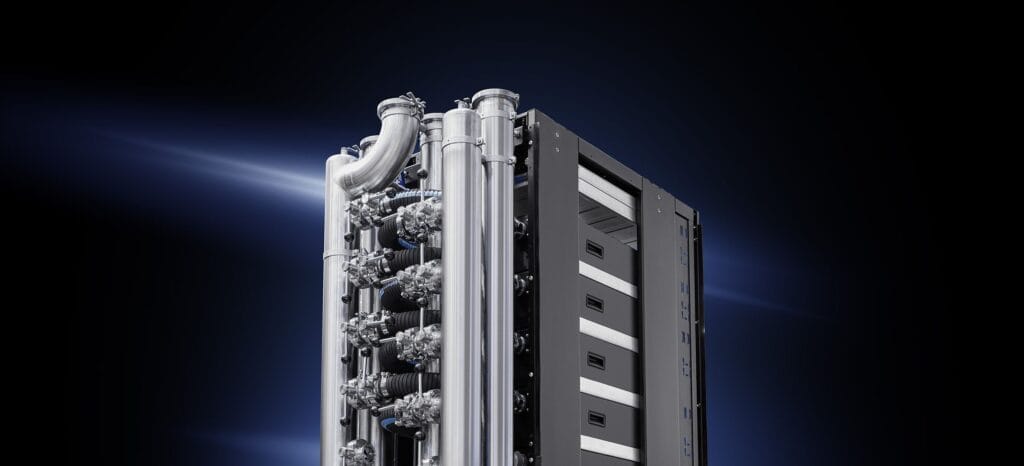Certainly! Here’s the translation of the provided text into American English:
The expansion of artificial intelligence (AI) is driving the transformation of data center infrastructures, which require increased processing power and, consequently, more advanced cooling systems. In response to this challenge, Rittal has developed an innovative modular cooling solution capable of providing over one megawatt (1 MW) of cooling power, optimizing energy efficiency and allowing for rapid scalability in data centers.
AI and the Growing Demand for Advanced Cooling
The exponential growth of high-performance computing (HPC) and the training of large language models (LLMs) has pushed traditional air cooling solutions to their limits. New high-performance graphics processors (GPUs), designed for AI-intensive tasks, generate extreme heat levels, making direct liquid cooling essential.
According to McKinsey, generative AI (GenAI) could contribute between $2.6 and $4.4 trillion annually to the global economy, leading to a massive expansion of IT infrastructure. As Philipp Guth, Technical Director at Rittal International, notes, “IT infrastructures must grow rapidly and be rethought from a technological perspective.”
In this context, Rittal has developed a modular liquid cooling system designed in collaboration with hyperscalers and large data centers, offering unprecedented energy efficiency.
Rittal’s Direct Liquid Cooling Modular Solution
Rittal’s new solution is based on a modular platform for single-phase direct liquid cooling with water, using easy-to-maintain coolant distribution units.
🔹 How does it work?
- Modularity with Open Rack V3: Inspired by the Open Compute Project (OCP), the system allows servers in the rack to connect directly to a centralized water circuit via standardized connections.
- Scalable and efficient system: The platform includes central cooling control and coolant circulation units (CCUs), which can be inserted into the rack according to power needs.
- High availability and redundancy: Designed with a redundant n+1 system to ensure continuous operation.
- Advanced monitoring: The system detection of leaks at the component level allows for maintenance without interruptions using hot swap technology for controllers, sensors, and pumps.
- Energy optimization: The power supply is managed via a standardized direct current (DC) bus system in the rack.
Over 1 MW of Cooling Power: Efficiency and Carbon Footprint Reduction
According to Lars Platzhoff, Director of Rittal’s cooling solutions business unit, “the flexible design of the platform allows for multiple combinations of modules, integrating all pillars of a data centerA data center or data processing center (DPC) OT: racks, cooling, power, monitoring, and security.”
💡 Key benefits of Rittal’s system:
✅ Cooling power of over 1 MW for high-density racks.
✅ Liquid-to-liquid solutions for data centers with water supply.
✅ Liquid-to-air cooling options, ideal for centers without a water supply.
✅ Heat recovery capability to reduce the carbon footprint, allowing reuse in district heating systems.
Integrated Rack Infrastructure: The Evolution of Data Centers
The trend in data centers points toward the direct integration of power, cooling, and monitoring within standardized racks. This modular approach facilitates scalability and optimization of energy consumption.
🔹 Main drivers of this evolution:
- Hyperscalers: Large data center operators need standardized solutions for rapid and efficient expansion.
- OEM server manufacturers: They are integrating liquid cooling racks into their products.
- Colocation centers: Companies requiring efficient and scalable infrastructures are adopting these new systems.
According to Guth, “this concept will become a global standard due to the increasing demand for power and scalability.”
Moreover, Rittal is not limited to the 21-inch Open Rack V3. The company is already working on versions adapted for 19-inch VX IT racks, expanding its offerings for different data center configurations.
Conclusion: Liquid Cooling as a Key Technology for AI
Direct liquid cooling is emerging as the key enabling technology for the future of AI and high-performance computing. With over 20 years of experience in high-density IT cooling and 30 years in industrial climate control, Rittal is leading the way towards more efficient, modular, and sustainable data centers.
🔜 Global Availability: Platzhoff states that “our goal is to make these solutions available to customers of all sizes as soon as possible.”
With this advancement, Rittal is redesigning cooling standards in the IT industry, ensuring that global infrastructure is prepared for the revolution of artificial intelligence.
via: spainDC

